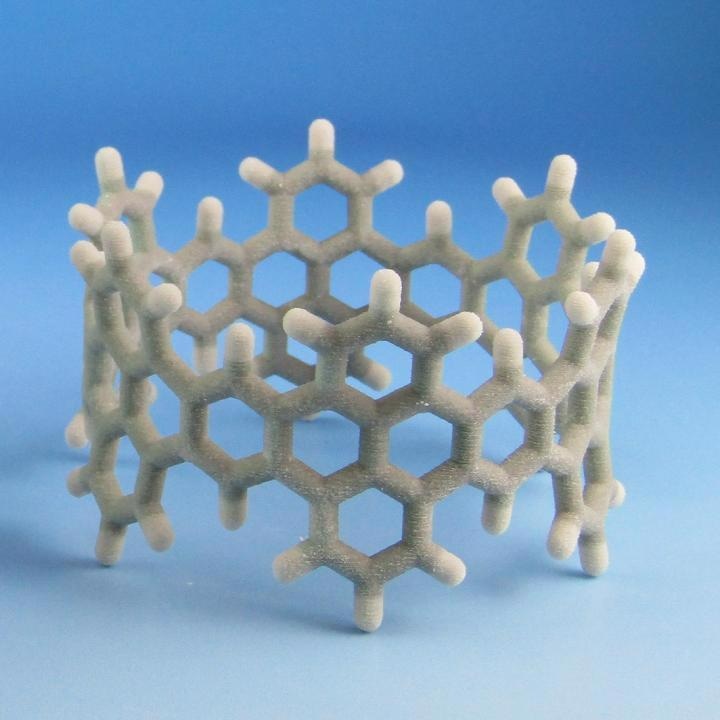Apr 2 2021
The existing technique for manufacturing carbon nanotubes—typically wrapped sheets of graphene—is not capable of enabling total control over their length, diameter, and type.

A model of the zigzag carbon nanobelt (with a magnification of 50 million) produced by a 3D printer at the Equipment Development Center, Institute for Molecular Science. Image Credit: NINS/IMS.
Recently, this issue has been resolved for two of the three different kinds of nanotubes. However, the third type, called “zigzag” nanotubes, is still unreachable. Now, scientists from Japan’s National Institutes of Natural Sciences (NINS) have discovered how to synthesize the zigzag variety.
The new technique has been explained in a paper published on January 25th, 2021, in the Nature Chemistry journal.
Carbon exhibits the special capacity to combine with other atoms to develop molecules, so when it combines with itself, it can do so in several structurally different ways (like graphite and diamonds) with various properties.
Over the past few decades, shapes like graphene—a layer of carbon with a thickness of one atom developed from a hexagonal honeycomb-like lattice—have been generated. A hollow graphene cylinder called a nanotube is another of such different forms, or “allotropes.”
In this honeycomb lattice, when the carbon hexagons in the nanotube get together, they develop a chiral, zigzag, or armchair configuration. The term “zigzag” is utilized for the configuration in which the “path” of every molecular bond between carbon atoms is guided initially leftward by 60°, then rightward by 60°, then left by 60°, then right by 60° again—a zigzag pattern.
The term “armchair” denotes a path that shifts twice left, and then twice right, before the pattern is repeated. This path apparently resembles an armchair, and hence the name has been given. A third kind called chiral falls between the two forms, together with its mirror image.
If a knife is used to slice through such tubes twice horizontally against the lengthwise axis, a “belt” of nanotubes, formed of 12 carbon hexagonal rings, can be produced. Such a belt is known as a “nanobelt.”
Measures taken to produce such nanobelts have been the subject of many scholarly studies. This is due to the drawbacks of the traditional manufacture of nanotubes, which takes a so-called “top-down” form. Top-down manufacture includes the pulverizations of a great mass of carbon into a powder, following which the nanotubes randomly develop themselves into one or more of the three types of configuration.
The problem here is that you can't control which configuration type is formed, or the diameter, or even the length. But if you can build a nanotube from the bottom up, from the 'seed' of a nanobelt, then you control all these three aspects.
Yasutomo Segawa, Study Corresponding Author, Institute for Molecular Science, National Institutes of Natural Sciences
An earlier study performed in 2019 could generate chiral and armchair nanobelts, but not the third type—the zigzag nanobelt.
For the first time, the NINS researchers could develop a zigzag nanobelt. The main aspect of the nanobelt synthesis approach was the bridging of the hexagonal rings by an oxygen atom (the addition of an oxanorbornadiene unit). Then, they could employ X-ray crystallography to verify that this structure, which had been forecast by theoretical calculations, was certainly developing in the real world.
Thanks to the synthesis of the third type of nanobelt, all three kinds of nanotubes—zigzag, chiral, and armchair—are in principle available currently. This is a huge step toward the bottom-up production of carbon nanotubes made to order.
The following step is to scale up this proof of principle to actual structure-selective bottom-up production of carbon nanotubes, through the synthesis of carbon nanotubes by using their nanobelts as seeds.
Journal Reference:
Cheung, K. Y., et al. (2021) Synthesis of a zigzag carbon nanobelt. Nature Chemistry. doi.org/10.1038/s41557-020-00627-5.
Source: https://www.nins.jp/en/